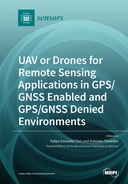Explore

UAV or Drones for Remote Sensing Applications in GPS/GNSS Enabled and GPS/GNSS Denied Environments
0 Ungluers have
Faved this Work
Login to Fave
The design of novel UAV systems and the use of UAV platforms integrated with robotic sensing and imaging techniques, as well as the development of processing workflows and the capacity of ultra-high temporal and spatial resolution data, have enabled a rapid uptake of UAVs and drones across several industries and application domains.This book provides a forum for high-quality peer-reviewed papers that broaden awareness and understanding of single- and multiple-UAV developments for remote sensing applications, and associated developments in sensor technology, data processing and communications, and UAV system design and sensing capabilities in GPS-enabled and, more broadly, Global Navigation Satellite System (GNSS)-enabled and GPS/GNSS-denied environments.Contributions include:UAV-based photogrammetry, laser scanning, multispectral imaging, hyperspectral imaging, and thermal imaging;UAV sensor applications; spatial ecology; pest detection; reef; forestry; volcanology; precision agriculture wildlife species tracking; search and rescue; target tracking; atmosphere monitoring; chemical, biological, and natural disaster phenomena; fire prevention, flood prevention; volcanic monitoring; pollution monitoring; microclimates; and land use;Wildlife and target detection and recognition from UAV imagery using deep learning and machine learning techniques;UAV-based change detection.
This book is included in DOAB.
Why read this book? Have your say.
You must be logged in to comment.
Rights Information
Are you the author or publisher of this work? If so, you can claim it as yours by registering as an Unglue.it rights holder.Downloads
This work has been downloaded 54 times via unglue.it ebook links.
- 54 - pdf (CC BY) at Unglue.it.
Keywords
- 3D registration
- accuracy
- aerial systems
- applications, inspection robotics, bridge inspection with UAS
- autonomous localization
- backpack mobile mapping
- bioinspired map
- bundle block adjustment
- change detection
- coastal mapping
- coastal monitoring
- Computer architecture
- consensus theory
- convolutional neural networks
- Data Collection
- Decision making
- deep learning
- Deep Reinforcement-Learning
- digital elevation models (DEMs)
- digital surface model
- direct georeferencing
- distributed state estimation
- DSM assessment
- emergency landing
- geomorphological evolution
- GNSS
- GPS-denied environment
- ground effect
- image alignment
- inspection
- Kalman filter
- Kilim River
- landing
- laser guidance
- machine vision
- map exploration
- moving camera
- multi-agent
- multi-robot
- multiple UAV navigation
- multirotor
- Navigation
- navigation in GPS/GNSS-denied environments
- onboard GNSS RTK
- OODA
- optical flow
- orthomosaic
- Particle Filter
- Photogrammetry
- POMDP
- Real-time
- Remote sensing
- search
- search and rescue
- Semantics
- sensor faults
- snow depth
- snow field
- snow mapping
- snow-covered area
- structure-from-motion (SfM)
- target detection
- technical guidelines
- Technology, engineering, agriculture
- Technology: general issues
- tidal phase
- topologic mapping
- UAS
- UAS traffic management
- UAV
- UAV imagery
- UAV photogrammetry
- UAV swarms
- underground cellars
- unmanned aerial system
- unmanned aerial vehicle
- unmanned aerial vehicles
- unmanned aerial vehicles (UAVs)
- video navigation
- vision and action
- vision-based navigation
- visual detection
- visual tracking
- water level changes
- YOLO
Links
DOI: 10.3390/books978-3-0365-1589-2Editions

